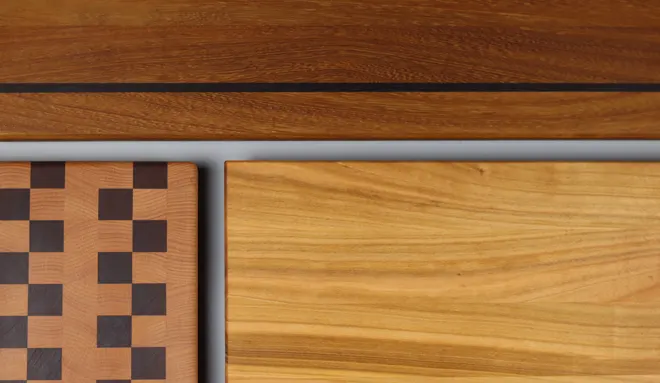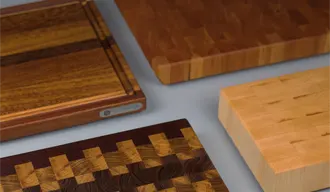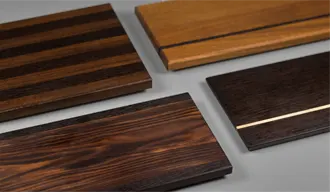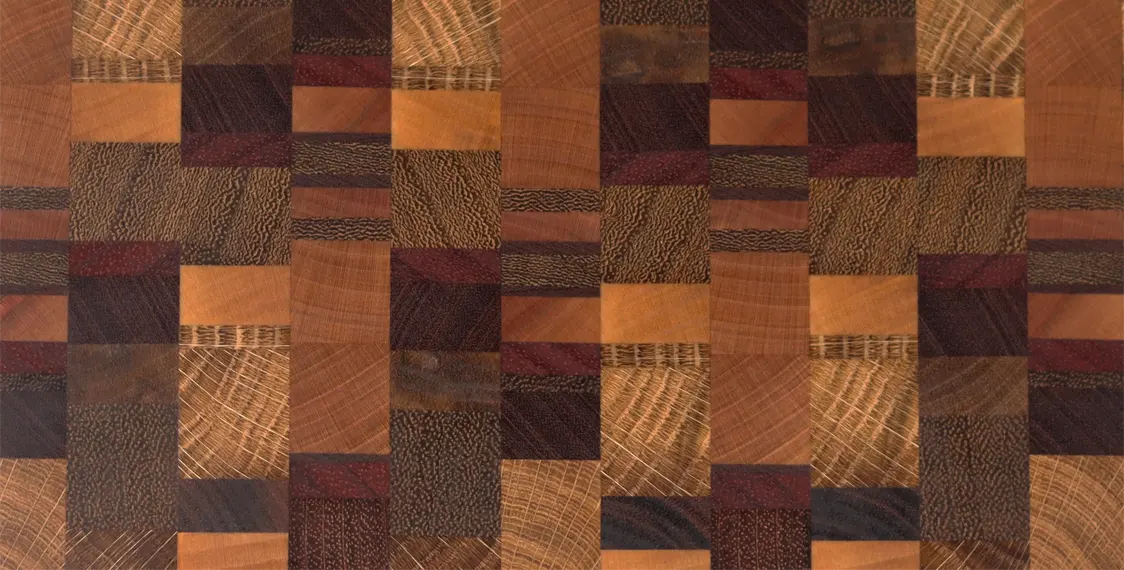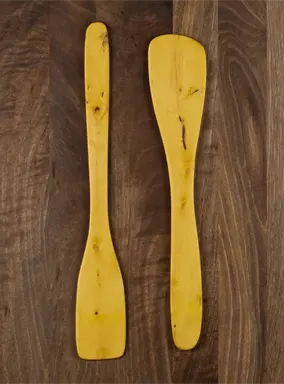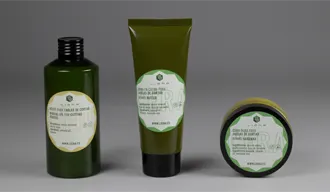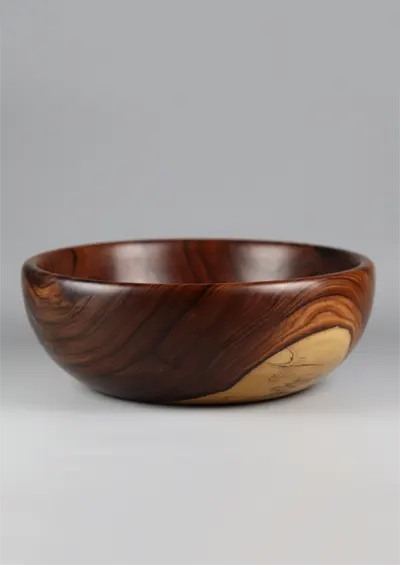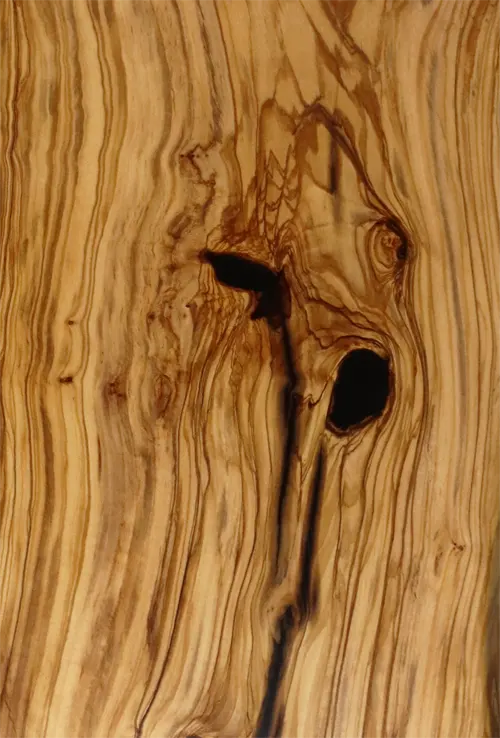Good Wood for Cutting Boards
Introduction
Choosing the right wood for cutting boards is essential for durability, hygiene, and preserving knife edges. This article reviews six excellent options of good wood for cutting boards —walnut, cherry, hard maple, oak, teak, and olive wood—highlighting their technical traits and practical suitability. Understanding their densities, hardness (Janka scale), and grain tightness will help you make informed, long‑lasting choices.
1. Walnut
Why it works
Walnut combines moderate hardness with fine pores, offering a board that is gentle on knives while resisting deep grooves where bacteria hide. Its rich color makes it attractive for presentation and everyday use. Overall is a good wood for cutting boards.
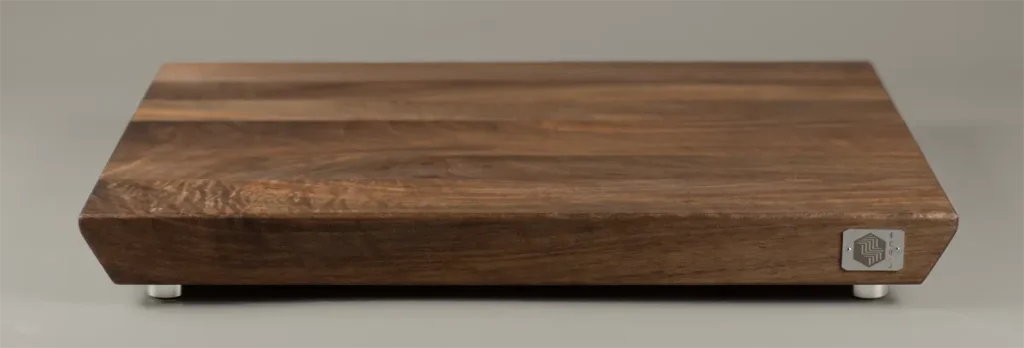
Technical Characteristics – Walnut
| Property | Specification |
|---|---|
| Janka Hardness | approx. 1,010 lbf |
| Density | ~660 kg/m³ |
| Grain Structure | Fine, closed‑grain |
| Natural Oils | Low |
2. Cherry
Why it works
Cherry heats up under repeated washings to a subtle, uniform patina without splintering easily. Its medium hardness protects your tools and provides durability with a smooth finish that’s easy to maintain. The best for high end japanese knifes.
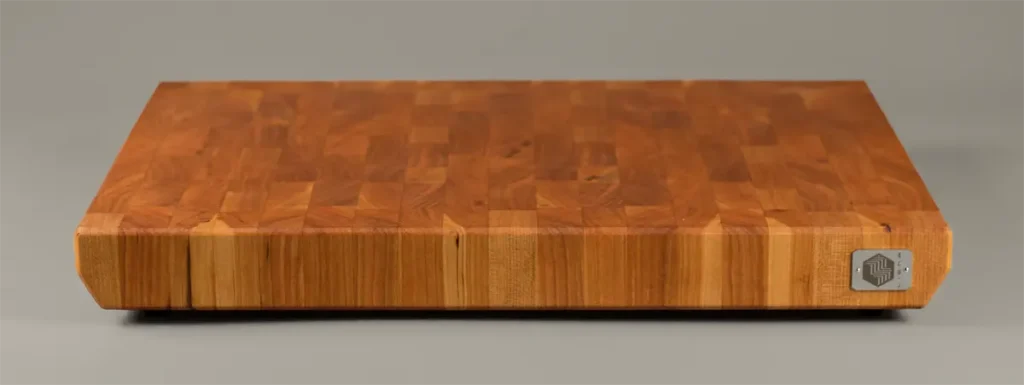
Technical Characteristics – Cherry
| Property | Specification |
|---|---|
| Janka Hardness | approx. 950 lbf |
| Density | ~600 kg/m³ |
| Grain Structure | Fine, closed‑grain |
| Natural Oils | Low |
3. Hard Maple
Why it works
Hard maple is the classic choice for butcher blocks and cutting boards: very hard, tight-grained, and hygienic. It resists deep cuts and microbial infiltration while retaining structural stability.

Technical Characteristics – Hard Maple (Sugar Maple)
| Property | Specification |
|---|---|
| Janka Hardness | approx. 1,450 lbf |
| Density | ~705 kg/m³ |
| Grain Structure | Very fine, closed‑grain |
| Natural Oils | Low |
4. Oak
Why it works
Oak brings high density and hardness, making it durable for heavy use. However, it has more open pores than maple or olive, which requires more maintenance to prevent bacterial growth. We consider it a very good wood for cutting boards.
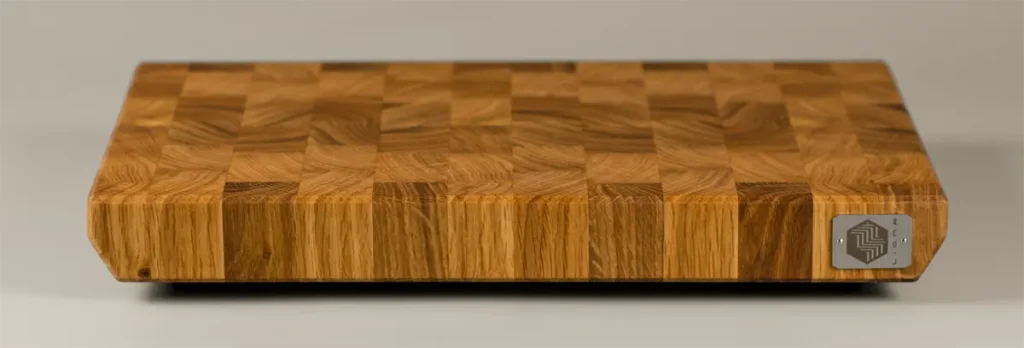
Technical Characteristics – Oak (White Oak)
| Property | Specification |
|---|---|
| Janka Hardness | approx. 1,360 lbf |
| Density | ~750 kg/m³ |
| Grain Structure | Open‑porous |
| Natural Oils | Low |
5. Teak and Iroko
Why it works
Teak and Iroko wood naturally contains silica and oils that resist decay and water damage, making it extremely durable. It’s well‑suited for environments where moisture is frequent, though the silica content can dull blades faster.
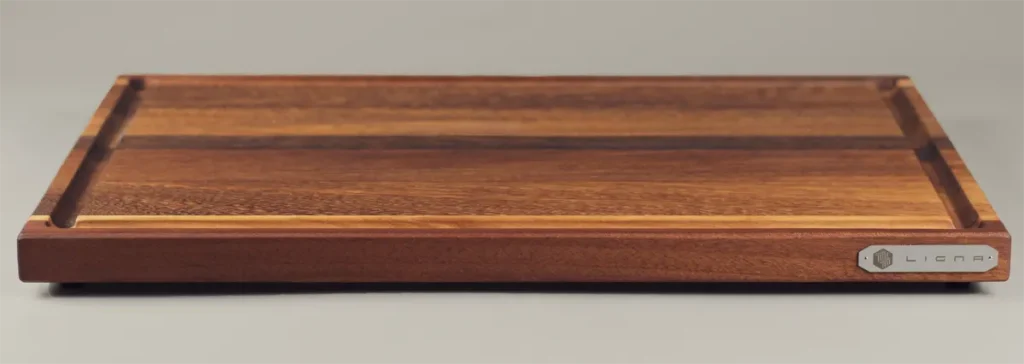
Technical Characteristics – Teak
| Property | Specification |
|---|---|
| Janka Hardness | approx. 1,070 lbf |
| Density | ~660 kg/m³ |
| Grain Structure | Medium, closed‑grain |
| Natural Oils | High |
6. Olive Wood
Why it works
Olive wood combines very high density and exceptionally tight grain, resulting in superb durability and water resistance. Its hardness preserves knife edges, and its dense grain discourages bacteria retention.
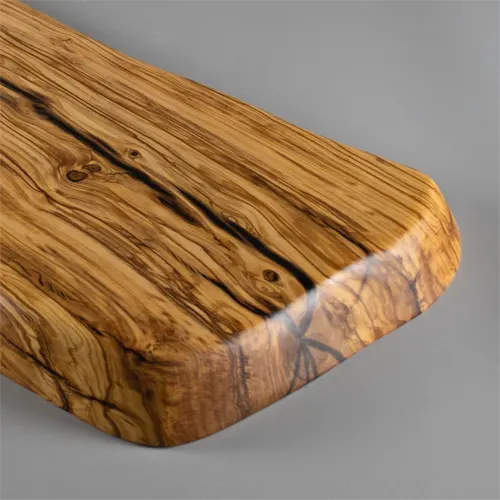
Technical Characteristics – Olive Wood
| Property | Specification |
|---|---|
| Janka Hardness | approx. 1,570 lbf |
| Density | ~820 kg/m³ |
| Grain Structure | Extremely fine, closed‑grain |
| Natural Oils | Moderate to high |
Quick Reference Table of good wood for cutting boards
| Wood Type | Hardness (Janka) | Knife-Friendliness | Maintenance Needs | Pros | Cons |
|---|---|---|---|---|---|
| Walnut | ~1,010 lbf | High | Low | Gentle on knives, attractive | Softer than maple |
| Cherry | ~950 lbf | High | Low | Consistent wear, patina develops | Softer than many hardwoods |
| Hard Maple | ~1,450 lbf | Medium–High | Moderate | Durable, hygienic, classic | Can dull knives gradually |
| Oak | ~1,360 lbf | Medium | Higher (due to pores) | Very durable, rugged look | Needs sealing/closer care |
| Teak | ~1,070 lbf | Medium | Low–Moderate (self-oiling) | Water-resistant, long-lasting | Silica may dull edges |
| Olive Wood | ~1,570 lbf | Medium | Low–Moderate | Extremely durable, water-resistant | Dense and may be heavy |
Conclusion
For a cutting board that balances durability, hygiene, and knife preservation, hard maple, olive wood, and walnut stand out. Hard maple offers exceptional resilience and hygienic properties; olive wood provides unrivaled density and water resistance; and walnut delivers knife-friendliness with refined aesthetics.
Cherry is a softer yet attractive option for lighter use; oak offers rugged strength for heavy-duty tasks if you manage maintenance conscientiously; teak is ideal for damp environments, though it may require more frequent blade honing.
Visit our store at ligna.es to find a fine selection of high quality cutting boards made with the best woods
FAQ about good wood for cutting boards
What makes hardwoods better than softwoods for cutting boards?
Hardwoods like maple, olive, and walnut have higher density and tighter grains, which reduce knife marks and resist bacteria-lodging grooves. Softwoods splinter more easily and degrade faster under chopping.
Is oak a safe choice for food preparation?
Oak can be safe if properly sealed and maintained; its open pores require more frequent cleaning and occasional food-safe oiling to prevent microbial retention. Its one of the most antibacterian woods due to tanin content
Why do some woods dull knives faster than others?
Woods containing silica or very high hardness—like olive wood—can wear down blade edges faster than softer or more forgiving woods like walnut or cherry. End grain cutting boards dull knives slower.
How often should I oil my wooden cutting board?
Depending on use and wood type, oiling is typically needed every 1–3 months. Woods like teak/self-oiling types may require less frequent maintenance, while more porous woods like oak need more consistent care.
Can I put any wooden board in the dishwasher?
No—heat and water exposure in dishwashers can cause warping, cracking, and loss of finish. Always hand wash and dry promptly.
What finish is best for cutting boards?
Food-safe mineral oil or butcher-block conditioning blends (often beeswax + oil) are ideal. Avoid vegetable oils that may go rancid and affect food or flavor.
Is olive wood worth the investment?
Yes—despite higher cost, olive wood delivers exceptional durability, water resistance, and beauty. It lasts longer and maintains integrity, making it cost-effective over time.
Can color or grain of wood affect cleanliness?
Not inherently—but lighter, closed-grain woods like maple may more clearly show stains or cut marks, helping you monitor wear and cleanliness.
Otras entradas del blog
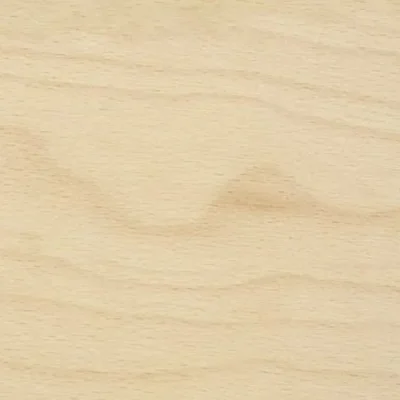
Birch Wood: Uses and Characteristics

Suar wood: uses and characteristics

Do I need a hardwood for a cutting board?
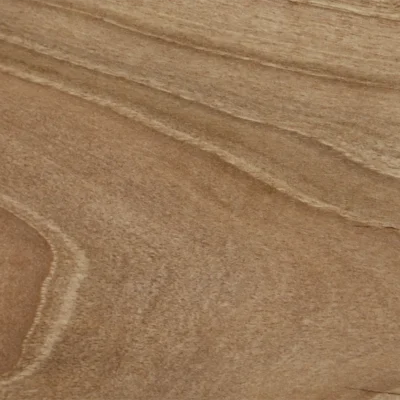
Walnut Wood: Uses and Characteristics
Nuestras tablas de cortar:

UMBRA
serving board
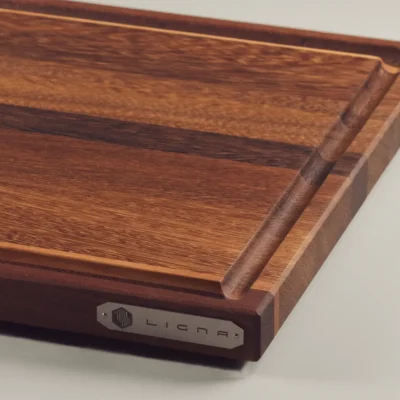
Chroma
large carving board
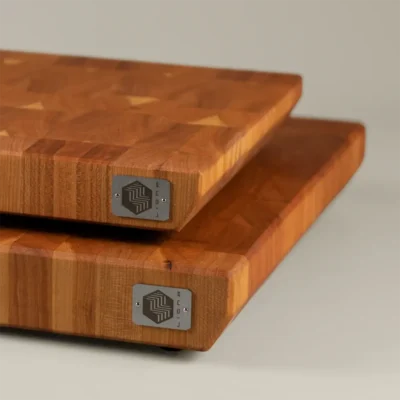
Pura
Cherry cherry butcher block
Pura
Cherrycherry butcher block
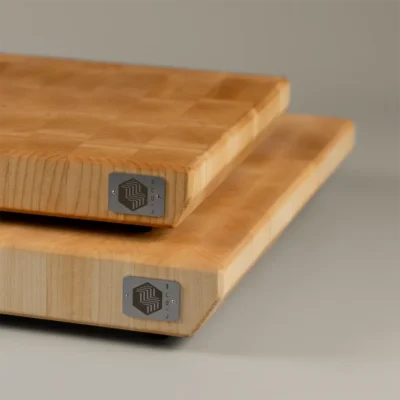
Pure
Maple maple butcher block
Pure
Maplemaple butcher block
